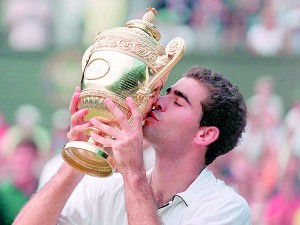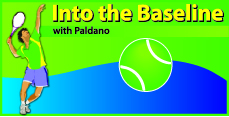Samprass’ only regret Tennis courts and tactics
View(s):Only a few international players were able to master stroke making and tactics to win on all types of court surfaces. Those few who succeeded, achieved the ‘career slam’ of winning all four majors in their life. Andre Agassi, Roger Federer, Rafael Nadal, Steffi Graf and Serena Williams made it. But not the mighty Pete Sampras, for him, not winning the ‘French Open’ remains an ‘unfinished job’.
The current European clay court circuit is due to end with the French open 2013 in the first week of June.
Davis cup choice
There are many types of courts. The most slippery of them all, is the ‘Talc and Crushed Sea shells’ surface. Playing on them is a ‘Holiday on Ice’ act. The standard surfaces are Grass, clay and Hard. Grass is fast and low bouncing, Clay is slow and medium bouncing. Hard is fast and high bouncing. Earlier indoor courts were wood and were the fastest. Most of the European Indoor courts have good hybrids. Davis Cup and Federation cup competitions permit host country the choice of surface. Sri Lanka always chose Clay. We are one of the few countries that still have clay courts. This choice has given us the edge to win many times.

Pete Sampras, for him, not winning the ‘French Open’ remains an ‘unfinished job’
Player classification
Player identity often has an inference to courts. The expressions ‘Grass court player’ and ‘Clay court player’ are common. The Court surface also plays a major part in player and game development. Good players can adapt to any surface within a week. However tactics are not easy to be accommodated. That is the challenge.
Clay courts
Sri Lanka did have a few Grass courts many years ago. They are gone. Hard courts are appearing now but the majority plays mostly on clay. Originally Ant Hill clay was used as it withstood the Sun better and dried faster after rain. Now, normal clay is used probably due to the scarcity of Ant Hill clay. In Europe Clay courts are crushed burnt bricks. Clay is comfortable and has no ill effects on the body. It is the slowest of all surfaces. Rallies are extended and winners are rare. Ground strokes dominate clay court game. Clay induces a lot of changes to the Ball with the bounce; it reduces great deal of speed which can change the trajectory vertically and laterally. Three Wimbledon champions Pete Sampras, Goran Ivanisevic and Borris Becker got very little advantage on clay with their big serve. Clay enhances Spin with extreme changes to the trajectory, making it difficult to play. In the all Spanish Barcelona finals of 2013 last week Nicolas Almagro was a victim of Nadal’s effective use of spin on clay.
Winning on clay court
Ground strokes are the base to play on clay. Being a slow surface the net game on clay needs special set-volleys with slice approach shot. It is almost a museum piece now. In the recent times Rohan de Silva had the best net game on clay. Former Davis Cup player and the coach D.D.N. Selvadurai made most of his points also at the net. Known as D.D.N in the Tennis circle, taught Tennis in Sri Lanka with an Australian certification in the 1960’s. His encouragement to play at net with the expression ‘chip and charge’ could be still heard in the local Tennis circle.
Our players need the net play for international success. The Asian physique does not have the capacity to tackle Open International Tennis with ground strokes. When compiling the game strategically, train to play two net rallies in a game and win a point with the serve. These will increase the chances of winning by 50 per cent. Clay court development is the best for an all round player. Grass court game
Currently, almost all the grass court tournaments are in England. ‘Bend your knees’ is an early instruction, to accommodate the low bounce of grass courts. The ideal game for grass is the net play. That means big serve, approach volley and decisive volley or two. Tactically Volley is not meant to rally. The original grass was very fast and gave irregular bounce, making passing shots, a nightmare. Wimbledon has successfully developed a special grass and made the game slow. It is Slow enough for the Spaniards to win the title. India’s Calcutta South Club has the best grass courts in Asia. For three generations many went to play Wimbledon from that club. Naresh Kumar, Jaideep Mukerjea, Premjit Lal and Akthar Ali are all from Calcutta.
Hard court
 The concrete base of the Hard court makes the ball bounce high. As a result most of the ball contacts are at eye level. To accommodate this, players use full and semi western grips. The swing too became short and goes round the body [Angular]. The stroke is capable of heavy spin. Hard court does not reduce the speed with the bounce. It encourages the use of power packed winners and makes the game vibrant to watch.
The concrete base of the Hard court makes the ball bounce high. As a result most of the ball contacts are at eye level. To accommodate this, players use full and semi western grips. The swing too became short and goes round the body [Angular]. The stroke is capable of heavy spin. Hard court does not reduce the speed with the bounce. It encourages the use of power packed winners and makes the game vibrant to watch.
There is a negative side to the hard court. Concrete base of the court has no ‘cushioning effect’ of the other surfaces. This strains the whole body. Stretching is considered an antidote for this problem. A good stretch is an hour long routine and very few go through that. Some of the biggest names have had their hip girdle, knee and even elbow replaced with artificial joints because of Hard court sessions. In Bangalore, recreational senior players are giving up Tennis in their fifties because of the hard courts’ effect on the physique. Hard court is easy to maintain so the court makers are looking for solutions to change this grave situation. Meanwhile good players are cutting their Hard court schedule to the minimum. After all who wants a metal hip?
Court and tactics
Tactics will have to be court oriented. Court influences coordination, timing and reaction time. Court surfaces are sensitive to temperature and wind too. They are considered to be a part of the court features which can be tactically exploited to win. -georgepaldano@yahoo.com
Follow @timesonlinelk
comments powered by Disqus


